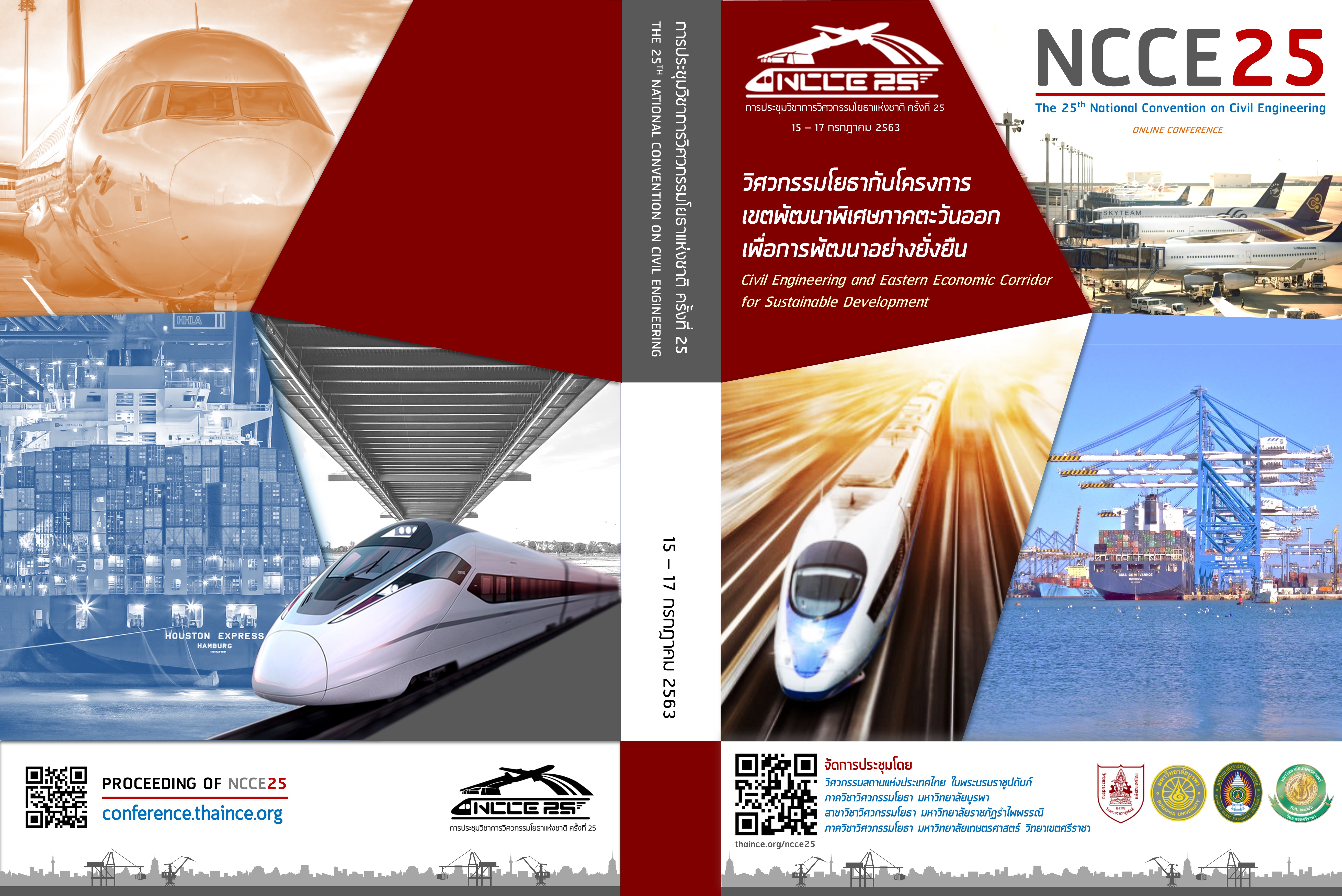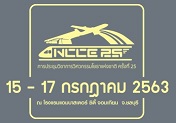การศึกษาเปรียบเทียบแบบจำลองกำลังรับแรงเฉือนของกำแพงเตี้ยคอนกรีตเสริมเหล็ก ภายใต้แรงแผ่นดินไหว
คำสำคัญ:
กำแพงเตี้ย, กำลังเฉือน, แผ่นดินไหว, คอนกรีตเสริมเหล็กบทคัดย่อ
บทความนี้ได้รวบรวมและทำการประเมินวิธีการคำนวณออกแบบแรงเฉือนของกำแพงเตี้ยคอนกรีตเสริมเหล็ก โดยเปรียบเทียบกับฐานข้อมูลผลการทดสอบ 657 ข้อมูล ซึ่งครอบคลุมตัวแปรสำคัญ วิธีการคำนวณออกแบบแรงเฉือนประกอบไปด้วยวิธีการตาม ACI 318-19 [8] Sánchez-Alejandre และ Alcocer [12] Gulec และ Whittaker[13] Kassem[14] Ning และ Lee [15] Hwang และคณะ[16] Baghi และคณะ[17] ผลการศึกษาพบว่า วิธีการของ Gulec และ Whittaker สามารถทำนายกำลังรับแรงเฉือนของกำแพงเตี้ยคอนกรีตเสริมเหล็กได้ถูกต้องกว่าวิธีการอื่น โดยมีค่าสัมประสิทธิ์ความแปรปรวนและค่าเฉลี่ยร้อยละของความคลาดเคลื่อน ต่ำที่สุด ในขณะที่วิธีการตาม ACI 318-19 มีความไม่แน่นอนสูงที่สุด นอกจากนี้ยังพบว่า วิธีการคำนวณทั้งหมดนี้ ให้ผลการทำนายที่ต่ำกว่าผลการทดสอบ เมื่อกำแพงมีค่ากำลังอัดคอนกรีตต่ำ
Downloads
เอกสารอ้างอิง
[2] Lefas LD, Kotsovos MD, Ambraseys NN. Behaviour of reinforced concrete structural walls: strength, deformation characteristics, and failure mechanism. ACI Structural Journal 1990;87(1):23–31.
[3] Gupta A, Rangan BV. High-strength concrete (HSC) structural walls. ACI Structural Journal 1998;95(2):194–205.
[4] Salonikios NT, Kaos AJ, Tegos IA, Penelis GG. Cyclic load behaviour of low slenderness reinforced concrete walls: design basis and test results. ACI Structural Journal 1999;96(4):649–660.
[5] Sittipunt C, Wood SL, Lukkunaprasit P, Pattararattanakul P. Cyclic behavior of reinforced concrete structural walls with diagonal web reinforcement. ACI Structural Journal 2001;98(4)
[6] Oh YH, Han SW, Lee LH. Effect of boundary element details on the seismic deformation capacity of structural walls. Earthquake Engineering and Structural Dynamics 2002;31(8):1583–1602.
[7] Liang X, Che J, Yang P, Deng M. Seismic behavior of high-strength concrete structural walls with edge columns. ACI Structural Journal 2013;110(6):953–963.
[8] American Concrete Institute. Building code requirements for structural concrete (ACI 318-19) and commentary (ACI 318R-19), Farmington Hills, Michigan; 2019.
[9] Wood SL. Shear strength of low-rise reinforced concrete walls. ACI Structural Journal 1990;87(1).
[10] Gulec CK, Whittaker AS, Stojadinovic B. Shear strength of squat rectangular reinforced concrete walls. ACI Structural Journal 2008;105(4):488–497.
[11] Gulec CK, Whittaker AS, Stojadinovic B. Peak shear strength of squat reinforced concrete walls with boundary barbells or flanges. ACI Structural Journal 2009;106(3):368–377.
[12] Sánchez-Alejandre A, Alcocer SM. Shear strength of squat reinforced concrete walls subjected to earthquake loading – trends and models. Engineering Structures 2010;32(8):2466–2476.
[13] Gulec CK, Whittaker AS. Empirical equations for peak shear strength of low aspect ratio reinforced concrete walls. ACI Structural Journal 2011;108(1):80–89.
[14] Kassem W. Shear strength of squat walls: a strut-and-tie model and closed-form design formula. Engineering Structures 2015; 84:430–438.
[15] Ning CL, Li B. Probabilistic development of shear strength model for reinforced concrete squat walls. Earthquake Engineering and Structural Dynamics. 2017; 46:877–897.
[16] Hwang SJ, Tsai RJ, Lam WK, Moehle JP Simplification of softened strut-and-tie model for strength prediction of discontinuity regions. ACI Structural Journal. 2017; 114(5):1239–1248.
[17] Baghi H, Baghi H, Siavashi S.Novel Empirical expression to predict shear strength of reinforced concrete walls based on particle swarm optimization. ACI Structural Journal. 2019; 116(5): 247–260.
[18] Gulec CK. Performance-based assessment and design of squat reinforced concrete shear walls. New York (United States): State University of New York at Buffalo; 2009.
[19] Adorno-Bonilla CM. Shear strength and displacement capacity of squat reinforced concrete shear walls. University of Puerto Rico Mayagüez Campus; 2016.
[20] Usta, M. Shear strength of structural walls subjected to load cycles. MS thesis, Purdue University, West Lafayette, IN, 2017.
[21] Hwang SJ, Fang WH, Lee HJ, Yu HW. Analytical model for predicting shear strength of squat walls. Journal of Structure Engineering ASCE 2001;127(1):43–50.
[22] Yu HW, Hwang SJ. Evaluation of softened truss model for strength prediction of reinforced concrete squat walls. Journal of Engineering Mechanics ASCE 2005;131(8): 839–846.
[23] Lim E, Hwang SJ. Modeling of the strut-and-tie parameters of deep beams for shear strength prediction. Engineering Structure 2016;108: 104–112.
[24] Chetchotisak P, Arjsri E, Teerawong J. Strut‑and‑tie model for shear strength prediction of RC exterior beam–column joints under seismic loading. Bulletin of Earthquake Engineering. 2020; 18:1525–1546.
[25] Paulay T, Priestley M. Seismic design of reinforced concrete and masonry buildings. New York: Wiley; 1992.
ดาวน์โหลด
เผยแพร่แล้ว
วิธีการอ้างอิง
ฉบับ
บท
การอนุญาต
บทความทั้งหมดที่ได้รับการคัดเลือกให้นำเสนอผลงานในการประชุมวิชาการวิศวกรรมโยธาแห่งชาติ ครั้งที่ 25 นี้ เป็นลิขสิทธิ์ของ วิศวกรรมสถานแห่งประเทศไทย ในพระบรมราชูปถัมภ์



